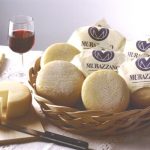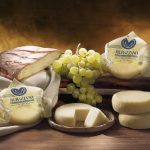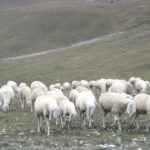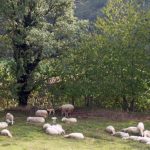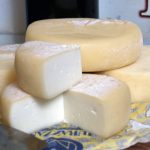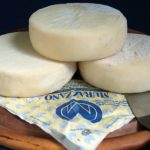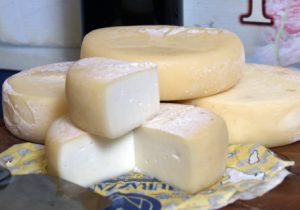
Name
Murazzano PDO
Seal of quality
Protected designation of origin with EEC Reg. 1263 dated 01/07/1996.
Description
Murazzano PDO is a fat fresh cheese produced from sheep’s milk, pure or in a percentage not inferior to 60%. Sheep’s milk comes mainly from the native breed Pecora delle Langhe (Langhe Sheep) that, after having been in danger of extinction, has experienced a significant revival thanks to the production of Murazzano cheese, although it still remains classified as being in danger of extinction.
Murazzano PDO comes in a cylindrical form with flat faces 10 – 15 cm in diameter and circumference height from 3 – 4 cm , weight ranging from 300 to 400 g . It is a milky white cheese and its texture is slightly thick, soft, sometimes with some holes. The outer part has no rind, is milky white for the fresh whole cheeses and straw yellow for the aged cheeses. Its taste, fine and delicately fragrant, recalls sheep’s milk with which it is made. Today, every whole cheese is still made by hand.
For its preparation, milk of the daily milkings, is coagulated at a temperature of 37° C with the addition of whey. The curd is deposited in cylindrical moulds with a holed bottom called “fascelle”, which in the past were made of wood and later of aluminium. It is then dry-salted, after which it is left to age – 6 days at least – during which the whole cheeses are washed daily with lukewarm water.
Nutritional characteristics
Follows the nutritional characteristics of Murazzano.
| unit of measurement | Murazzano | |
|---|---|---|
| protein ss | g/100g | <38 |
| lipids ss | ||
| with mixed milk | g/100g | 45 |
| with ovin milk in purity | g/100g | 48 |
| ashes ss | g/100g | 3 |
| humidity | % | <50 |
Area of production
Murazzano PDO is produced and aged in about 50 Communes of the Alta Langa area of Cuneo.
History
On market day, with their baskets covered with chequer towels, the women of the Alta Langa would go to Murazzano. They would set off, some on foot, others by bike, the luckier ones maybe even by bus, to go and sell their “tume” to the shopkeepers, who would then bring the cheese to the shops in towns on the plains, even as far away as Turin. Not only did the women go to the market to sell the cheese made during the week, for very little money, and buy food that was absolutely necessary, but they also saw to the milking.
The history of the “tuma” produced in the Langa area of Cuneo is, therefore, tightly tied to the history of the women of this land, the work of whom it was to look after the sheep, the production and cheese selling. However, its history is also linked with that of the Commune of Murazzano, an old production and trading centre. The first “Mostra concorso delle robiole” (Robiola cheese competition) was organised at the beginning of the 60s.
In 1982, Murazzano cheese won the national P.D.O. status and subsequently the European P.D.O. status. In the meantime, the “Consorzio per la tutela del formaggio Murazzano”, with the purpose of promoting and safeguarding this typical dairy production of the province of Cuneo.


